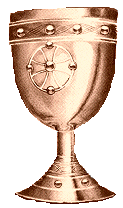

Excellent Story Telling from
Numerous Imaginative Authors
Following Geoffrey of Monmouth's Historia, new authors added more and more material to the snowballing legend. Some notable references being:
"Roman
de Brut" : Wace, AD 1155. Wace was the first to mention
Arthur's "Round Table". Said to seat fifty knights, the circular
shape produced a feeling of equality. It's highly unlikely that
such a table existed in the Arthurian timeframe, though it might have
been discussed as a symbol of the concept of equality. The
Winchester Round Table was most likely built during the reign of King
Edward I (1239-1307). The order "Knights of the Round Table" has
a medieval character like that of the historical Knights
Templar and Knights
of St John


"Erec
et
Enide", "Cligè
Chré
Chré
"Tristan" : Gottfried
von
Strassburg - c.1210. Gottfried
developed the Tristram and Isolde story, first related by Thomas of
Britain, c.1185, in his poem Tristan.
Later on this story was incorporated into
Arthurian legend by Sir Thomas Malory.
"Sir
Gawain and the Green Knight"
:Unknown, fourteenth century. Interestingly J.R.R.
Tolkien of
"Lord of the Rings" fame worked as a co-editor for the Clarendon Press
on the first edition published in 1925.
"Le
Morte d'Arthur": Sir
Thomas Malory c.1470. This has
became the classic and most
famous reference to the Arthurian legend
There has been much debate about Camelot.
Historically it is likely that King Aidan mac Gabran and his
sons, including Arthur, may well have used the Roman fort of Camelon,
near Falkirk, as a base during military campaigns against the
Picts. However, the Camelot described in Arthurian legend is
closer in character to King Cole's Roman town of Camulodunum, now known
as Colchester.
Avalon is most commonly related to Arthur's supposed
final battle at Camlan. Unfortunately the first reference to
Camlan in the Annales
Cambriae does not seem to have a
source. By inference the Battle of Camlan and the trip to Avalon
are highly likely to be fictional. However, let's not
spoil the fun, we can still try and relate real places to the
literature places. Probably the best candidate for Camlan is
Afon Gamlan
in North Wales. Places we might identify with Avalon are Avilion
in France, the holy island of Iona, Bardsey Island off North Wales, and
Caldey Island near Tenby.
"Holy Grail" is the English for "San Graal" which came
from the original "Sangreal". The more popular interpretation is
that of a holy chalice or cup with life giving properties. This
might also be the origin of the life restoring cauldron described in
the The
Mabinogion . However, there is
an intriguing alternative interpretation. The phrase "Sangreal"
can be separated as "Sang Real" instead of "San Greal".
This translates as "Royal Blood". The dual interpretations are
probably a deliberate intention. The grail can be thought of as a
symbol for carrying royal blood down the ages. In
1982, Michael Baigent, Richard Leigh, and Henry
Lincoln wrote The
Holy Blood and the Holy Grail, which claims to give a true
historical account of how Jesus lawfully wedded Mary Magdalene
and traces a line of descent to the Merovingian
dynasty in France. In "Bloodline
of the Holy Grail", Laurence
Gardner claims a line of descent
from the Merovingian dynasty to the House of Stewart and even a current
day "Prince
Michael of Albany". Genetic research might confirm
whether the claims are true or false, but cooperation from the Roman
Catholic Church and the UK Establishment is highly unlikely. In
2003 Dan Brown showed that there is money to be made from the Holy
Grail when he fictionalised the earlier work of Baigent, Leigh and
Lincoln to produce The Da Vinci Code. Brown later faced court action from the HBHG
authors even though he'd paid some homage to them with the creation of
the character "Leigh Teabing". The court found favour with Brown,
but the resulting publicity had boosted sales of HBHG, so everyone was
happy.
